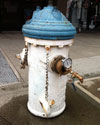Protecting San Francisco against fires
Aaron Lee was recently named to the ASCE’s 2015 New Faces of Engineering list, which recognizes the next generation of leaders who demonstrate a clear vision, good managerial and technical skills, and who possess inspirational leadership qualities and a desire and willingness to change the world for the better.
As a resident of San Francisco, earthquake risk is a reality that I am always aware of. Although ground shaking will cause damage, fires following an earthquake are just as problematic. After the 1906 earthquake devastated the city, the fires that followed were the worst in the history of the United States. As a result, San Francisco built a separate water system, the Auxiliary Water Supply System (AWSS), specifically to fight large conflagrations.
The system includes a reservoir and two tanks, and the original network used extra-thick pipe. Two pump stations along the coast can also feed the system with water from the bay, and underground cisterns dot the city as standalone water sources. Due to the age and the limited coverage of the AWSS, AECOM was selected to perform a capital-planning study on how to improve and potentially expand the system. My involvement focused primarily on the hydraulic and reliability-modeling aspects of the project, which utilized probabilistic methods to evaluate system performance and the proposed improvement projects.
 The biggest challenge was to determine the best way to represent and test the system with the information available to us. This process required our team to work closely with reliability and seismic-modeling experts, the San Francisco Public Utilities Commission (SFPUC), and other stakeholders, such as the San Francisco Fire Department, to create a methodology that was defensible and useful to determine future capital improvements. Ultimately, we had to create new processes and tools to help the SFPUC make the decisions needed for improving the AWSS. It is absolutely gratifying to see some of our recommendations being built right now in the city. Next time you are in San Francisco and you notice two different fire hydrants or brick rings in the streets, you’ll know that it’s the AWSS, ready to put out fires when “the big one” hits.
The biggest challenge was to determine the best way to represent and test the system with the information available to us. This process required our team to work closely with reliability and seismic-modeling experts, the San Francisco Public Utilities Commission (SFPUC), and other stakeholders, such as the San Francisco Fire Department, to create a methodology that was defensible and useful to determine future capital improvements. Ultimately, we had to create new processes and tools to help the SFPUC make the decisions needed for improving the AWSS. It is absolutely gratifying to see some of our recommendations being built right now in the city. Next time you are in San Francisco and you notice two different fire hydrants or brick rings in the streets, you’ll know that it’s the AWSS, ready to put out fires when “the big one” hits.
While not running hydraulic models, I am also involved in working on sustainability for infrastructure projects. There is a new sustainability framework and rating system called Envision, which is meant to be used on a broader range of infrastructure types such as pipelines, roadways, parks, etc. Right now, I am serving as the sustainability manager using Envision for a wastewater treatment plant upgrade project for the City of Davis in California. My role is to work closely with the design team to ensure that the design elements and construction processes follow the sustainability metrics prescribed in the Envision system. Our goal is to make sure that the work we do aligns with the sustainability targets for the city. This project is exciting because Envision is fairly new, and the work we are doing can set precedents for similar projects in the future.
Outside of the office, I volunteer with the San Francisco Professionals Chapter of Engineers Without Borders – USA. You can read about my recent trip to Fiji on my previous blog post on the AECOM Impact blog. Our team is currently planning our next implementation trip this summer to build a new 20,000-liter reinforced concrete water storage tank for one of the villages, and I am excited to continue working to bring clean and reliable water to three villages in rural Fiji.
Check out Aaron’s video of his work below:
 Aaron Lee (Aaron.Lee@aecom.com) is a civil engineer with AECOM’s water business unit in the San Francisco office.
Aaron Lee (Aaron.Lee@aecom.com) is a civil engineer with AECOM’s water business unit in the San Francisco office.
LinkedIn: Aaron Lee, P.E.






